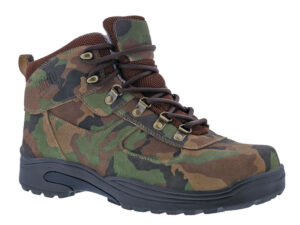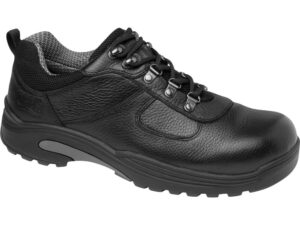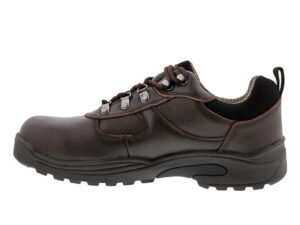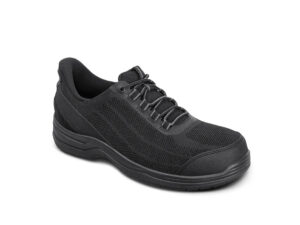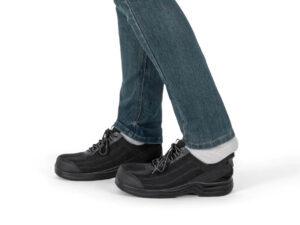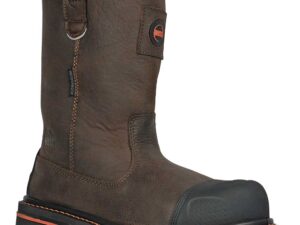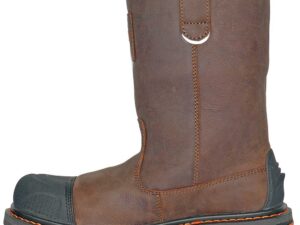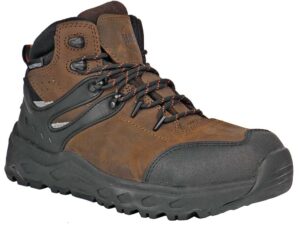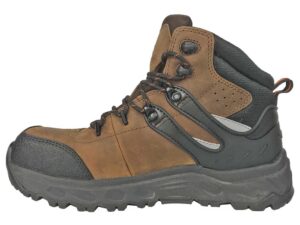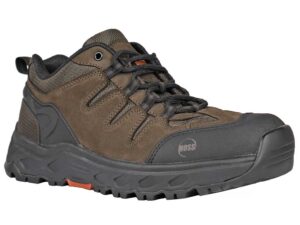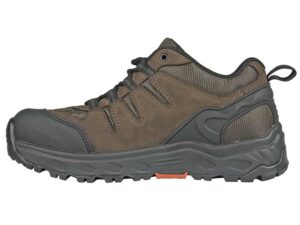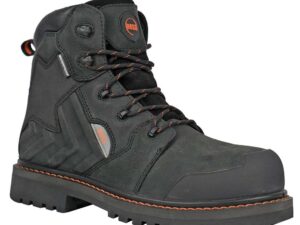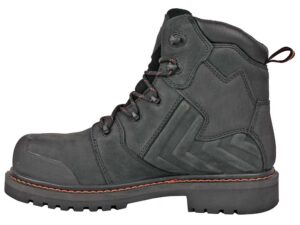Choosing the right footwear for the job site is a decision that goes beyond aesthetics. It’s a matter of safety, comfort, and performance. In the debate between 6e Steel Toe Boots and Composite Toe Boots, there are several critical aspects to consider. This article will explore these two types of boots in depth, including ASTM-compliant safety standards, the impact of boot weight on fatigue, the importance of a proper fit for those with wider feet, differences in cold weather performance, and considerations when passing through security checkpoints with metal detectors.
- The Basics of 6e Steel Toe and Composite Boots
- ASTM-Compliant Safety – ASTM F2412
- Weight and Fatigue: What You Need to Know
- Finding the Right Fit for Wider Feet
- Cold Weather Affects
- Comfort Considerations
- Security Checkpoints and Your Boots
- Conclusion and Next Steps
The Basics of 6e Steel Toe and Composite Boots
Steel Toe Boots: Built Tough
Steel toe boots have been the traditional choice for construction workers for decades. With a steel cap embedded in the toe area, these boots are designed to withstand heavy impact and compression. Imagine a heavy tool or piece of equipment falling on your foot; the steel toe acts as a shield, preventing serious injury. For those working in environments with heavy machinery and potential falling objects, steel toe boots are a tried-and-true option. Check out what to look for in a wide work boot in this wide-width work boots for men blog.
Composite Toe Boots: Light and Strong
Composite toe boots offer a modern alternative to steel, providing similar protection without the added weight. Made from non-metal materials like carbon fiber, these boots can be a game-changer for those long shifts. Imagine working a 12-hour day; the reduced weight can make a significant difference in fatigue levels. Consider the men’s composite toe work boot by Apis for a contemporary approach to safety.
Steel vs Composite: A Personal Choice
When it comes to choosing between steel toe boots and composite toe boots, both types have their unique advantages, and the right choice depends on your specific needs and work environment.
Steel Toe Boots:
- Strength: Steel toe boots are renowned for their robust protection. The steel cap can withstand significant impact, making them ideal for environments with heavy machinery and potential falling objects.
- Durability: Steel is known for its long-lasting properties. If you’re looking for boots that can take a beating and last for years, steel toe boots are a solid choice.
- Heat Resistance: Steel can withstand higher temperatures, making these boots suitable for jobs that involve exposure to heat.
Composite Toe Boots:
- Lightweight: Composite toe boots are made from non-metal materials like carbon fiber, making them lighter. This can reduce fatigue during long working hours.
- Cold Weather Performance: Unlike steel, composite materials do not conduct cold, making these boots a preferred choice in colder climates.
- Security Checkpoints: Being metal-free, composite toe boots allow for smooth passage through security checkpoints with metal detectors.
Here’s a chart to help you compare the two:
| Feature | Steel Toe Boots | Composite Toe Boots |
|---|---|---|
| Impact Protection | Strong | Strong |
| Weight | Heavier | Lighter |
| Cold Weather Performance | Conducts Cold | Insulates Against Cold |
| Security Checkpoints | May Trigger Alarms | Smooth Passage |
| Durability | Highly Durable | Durable |
| Heat Resistance | Suitable | Less Suitable |
Consider your daily tasks, the specific demands of your job, and personal preferences when making this critical decision. Whether you need the unyielding strength of steel or the lightweight comfort of composite, both types offer valuable benefits. Explore options like the leather composite toe work boot for a balance between comfort and protection.
ASTM-Compliant Safety – ASTM F2412
Safety is paramount on the construction site, and both steel and composite toe boots must meet ASTM F2412 standards. This ensures that your boots are up to the task, providing the necessary impact and compression resistance. Whether you’re working with heavy machinery or navigating a site filled with potential hazards, adherence to these standards guarantees your protection.
Here are some of the key standards under ASTM F2412:
- Impact Resistance: The boots must withstand a certain amount of impact to the toe area without showing signs of cracking or breaking.
- Compression Resistance: The boots must resist compressive loads, protecting the foot from being crushed or pinched.
- Metatarsal Protection: Some boots include protection for the metatarsal region of the foot, guarding against impact from falling objects.
- Conductive Properties: This measures the boot’s resistance to the flow of electricity and ensures that the footwear is not a source of electrical shock.
- Electric Hazard Protection: Boots that meet this standard provide a secondary source of protection against accidental contact with live electrical circuits or conductors.
- Static Dissipative Properties: This ensures that the boots can dissipate the electrostatic charge in a controlled manner, reducing the risk of static sparks.
- Puncture Resistance: Some boots are designed to resist punctures from sharp objects on the ground, such as nails or shards of glass.
Please note that the specific standards can be updated at any time, and the above list may not cover all the details. To learn more about the current ASTM F2412 standards for protective footwear, you can visit this link.
It’s not just about meeting regulations; it’s about going home safely at the end of the day. By choosing boots that comply with ASTM F2412, you’re investing in your safety and well-being on the job site.
Weight and Fatigue: What You Need to Know
The weight of your boots can significantly affect your fatigue levels. Steel toe boots, while offering solid protection, can be heavier. Imagine carrying an extra pound on each foot all day; it adds up. Composite boots, being lighter, can help you stay on your feet longer without feeling worn out. Think about those long shifts and the toll they take on your body; the right boots can make a world of difference.
Finding the Right Fit for Wider Feet
The Importance of a Good Fit
A proper fit is essential, especially for those with wider feet. Ill-fitting boots can lead to discomfort, blisters, and even long-term health issues. Both steel and composite toe boots come in various widths, ensuring a comfortable fit. Explore our work boot men collection for the right size. Remember, a boot that fits well isn’t just about comfort; it’s about performance and safety too.
Work Boots For Men
Customized Comfort
Brands like Apis, Propet, and Orthofeet offer boots that cater to wider feet. A good fit not only enhances comfort but also improves overall performance on the job site. Think about those long days on uneven terrain; a boot that fits well supports your foot, reducing strain and the risk of injury.
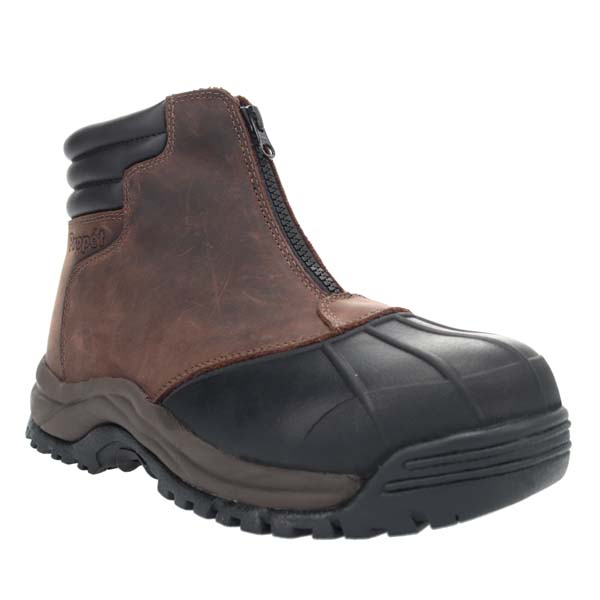
Cold Weather Considerations
Steel Toe Boots in the Cold
Steel toe boots can conduct cold, making them less suitable for freezing temperatures. If you’ve ever worked in the dead of winter, you know how important warm feet are. The cold can penetrate the steel cap, leading to discomfort during those chilly months.
Composite Toe Boots: A Warmer Option
Composite toe boots provide insulation against the cold, ensuring that your feet stay warm and comfortable. If your job takes you outdoors in winter, this can be a significant advantage. The non-metal materials provide a barrier against the cold, allowing you to focus on the task at hand. The Blizzard, an all-weather work boot offer options that balance weight and protection in cold climates.
Choose Wisely
Consider the weather conditions in your region when making your decision. The right choice can make a significant difference in your daily comfort. Whether it’s the heat of summer or the chill of winter, your boots need to perform.
Comfort Considerations: Smoother Toe Box
Composite Toe Caps: Enhanced Comfort for All, Including Diabetics
Composite toe caps, known for their smoother toe box, offer a level of comfort that can be particularly beneficial for individuals with specific health considerations, such as diabetics. Diabetics often experience sensitivity in their feet, and a smoother toe box can reduce pressure points and minimize irritation. For example, a diabetic construction worker may find that composite toe boots provide a more forgiving fit, reducing the risk of blisters or sores. The lightweight nature of composite materials also contributes to overall comfort, allowing for more natural movement. Importantly, composite toe caps meet the ASTM F2412 standards, ensuring that they provide the necessary safety without compromising on comfort.
Steel Toe Caps: Safe but Consider Comfort
Steel toe caps also meet the ASTM F2412 standards, providing robust protection on the job site. However, the more rigid structure of steel toe caps might not offer the same level of comfort in the toe box area, especially for those with specific health needs like diabetes. While entirely safe and effective in protecting against impact and compression, steel toe boots may feel less accommodating, particularly during long working hours. For someone with diabetes, who needs to pay extra attention to foot care, this rigidity might exacerbate existing issues or create discomfort over time.
The choice between composite and steel toe caps should consider both safety and comfort. Both options are safe, meeting the required standards, but the smoother toe box of composite toe caps might offer a more comfortable experience, especially for those with specific health considerations like diabetes. Understanding your individual needs and the unique benefits of each type can help you make an informed decision that ensures both safety and well-being on the job site.
Security Checkpoints and Your Boots
Steel Toe Boots and Metal Detectors
If you frequently pass through security checkpoints with metal detectors, steel toe boots may trigger alarms. This can lead to delays and inconvenience, especially if you’re moving between different sites or areas with heightened security.
Composite Toe Boots: A Smooth Passage
Composite toe boots allow for smooth passage through security checkpoints, saving time and avoiding interruptions. If your work involves frequent security checks, this can be a crucial consideration. Time is money, and the right boots can keep you moving.
Balancing Safety, Comfort, and Health
Choosing between 6e Steel Toe Boots and Composite Toe Boots is not merely a decision about safety; it’s a comprehensive consideration that includes comfort, fatigue management, and overall foot health. Both options meet the ASTM F2412 standards, ensuring robust protection on the job site. However, the differences in weight, toe box design, and material can significantly impact daily comfort and long-term well-being.
For those on their feet for extended periods, such as construction workers, the weight and design of the boots can influence fatigue levels. A lighter, smoother toe box, as found in composite toe boots, can reduce pressure points and enhance comfort, particularly for individuals with specific health needs like diabetes. On the other hand, the strength and durability of steel toe boots offer a different set of advantages that might be more suitable for certain work environments.
Foot health is a vital aspect of overall well-being, especially for those in physically demanding professions. The right pair of boots can make a world of difference, not just in preventing injuries but also in promoting overall comfort and reducing fatigue. By understanding the unique characteristics of both steel and composite toe boots, you can make an informed decision that aligns with your specific needs and job requirements.
Remember, the right footwear is not just about meeting safety standards; it’s about supporting your feet in the best possible way, day in and day out. Because at the end of a hard day’s work, happy feet make all the difference.
Keep Those Feet Happy
For more questions or personalized assistance, feel free to contact DT Footwear. Our team is here to help you find the perfect pair that meets safety standards and keeps your feet happy. Because at the end of a hard day’s work, happy feet make all the difference.


